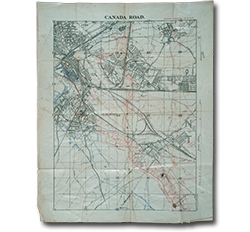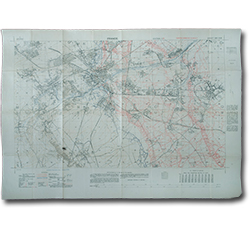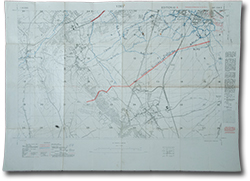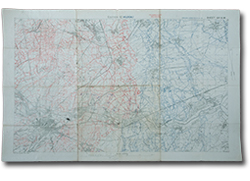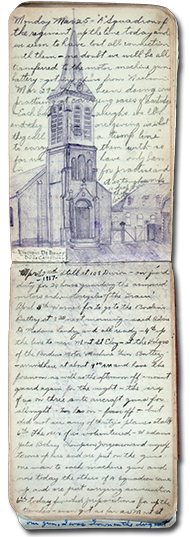The 100th anniversary of the First World War is now finished but the records will continue to be preserved at the Archives and accessible to current and future generations who want to know more about the time period. In addition, this blog will remain on our website as an additional resource.
From April 2016 to April 2017, this blog featured the First World War letters of one Manitoba soldier, George Battershill, of East Kildonan. Most of the letters were written to his mother or to his father. The blog follows the letters that George wrote in the same week, one hundred years ago.
March 2017 Posts:
- 30 March: 100th Anniversary of the Battle of Vimy Ridge: Trench maps
- 27 March: One Manitoba Soldier: A postcard for Mother
- 23 March: 100th Anniversary of the Battle of Vimy Ridge: A soldier's diary
- 20 March: One Manitoba Soldier: “Remember me to anybody that I know”
- 15 March: Manitobans at the Battle of Vimy Ridge
- 13 March: One Manitoba Soldier: Opened by censor
- 6 March: One Manitoba Soldier: George's 20th birthday
30 March 2016
100th Anniversary of the Battle of Vimy Ridge: Trench maps
The Archives of Manitoba has a small collection of trench maps from the First World War which are part of our Archives of Manitoba map collection. These particular maps were donated to the Archives in 1982 by the Manitoba Liquor Control Commission. We do not know how these maps came to be in their possession, but we are glad to have them at the Archives.
Trench maps are an interesting source for documenting the changing face of the war. They show the shifting position of the front line and the associated military trenches. They also show the names given to trenches and other landmarks.
These maps from the area surrounding Vimy show several landmarks and trenches with Canadian names. The Canada Road map below includes both a Winnipeg Road and a Brandon Road.
It is interesting to note that the colours used for the German and British trenches was changed early in 1918. The British trenches were blue and then became red (as in the first two maps above); while the German trenches went from red to blue. Warning of this change is noted on the 4th map below:
“NOTE CHANGE OF COLOUR British Trenches RED German Trenches BLUE.”
These maps show the area around Vimy Ridge but they were drawn after the Battle of Vimy Ridge, some in the fall of 1917 and one in 1918. They may have been carried by Canadian soldiers to the front lines.
Search Tip: Search the “trench map” in the Archives of Manitoba map collection in Keystone to find additional maps.
Feedback (0)
E-mail us at [email protected] with a comment about this blog post. Your comments may be included on this page.
27 March 2016
One Manitoba Soldier: A postcard for Mother
This week’s letters include only a field service postcard (also known as a whiz bang postcard) sent by George to his mother on March 30, 1917. George uses the postcard to indicate that he is well and has received both a letter and a parcel.
The postcard is postmarked in East Kildonan on April 30, thirteen days after George died in France. (George was injured at Vimy Ridge and died of his wounds on April 17, 1917. Read more in next month’s blog posts.)
Find out more about whiz bang postcards in our 8 June 2015 blog post.
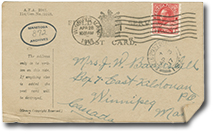
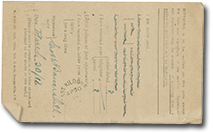
enlarge (2 images)
Archives of Manitoba,
Battershill family fonds,
Field Service Post Card from George Battershill,
March 30, 1917,
#872, P7471/5.
Search Tip: Search the Battershill family fonds in Keystone for more information. All of the George Battershill letters have been digitized and can be read from the database (if you can’t wait for the weekly installments!).
Feedback (0)
E-mail us at [email protected] with a comment about this blog post. Your comments may be included on this page.
23 March 2016
100th Anniversary of the Battle of Vimy Ridge: A soldier's diary
Soldiers’ diaries are excellent records of wartime. In a diary a soldier could write extensively about what he saw and did at the Front. Manitoban George Henry Hambley kept a detailed diary throughout his participation in the First World War. (Hambley was a trooper in the Canadian Light Horse who served in France, Belgium, and Germany, fighting in the battles of Ypres, Mons, Cambrai, and Vimy Ridge. Read more in our blog post from 22 April 2015.)
Hambley documents his experience of the war in great detail in his diaries, not just in words but with drawings, photographs, poems, songs and maps. In his third diary (of thirteen that he wrote during the First World War) he records his experiences leading up to and during the Battle of Vimy Ridge, almost 100 years ago.
Hambley was dismounted from his horse for the battle and temporarily assigned to a Machine Gun brigade.
On 29 March 1917 he writes:
“Have been doing some practising at carrying cases of cartridges – Each box weighs 100 lbs and they are giving us what they call a ‘tump line’ to carry them with so far we have only been in for practise and it is tough work, a strap on the head.”
On 6 April:
“The six of us volunteered – Wadams Yates Bohney Thompson Jorgenson and myself to come up here and are put on the guns one man to each machine gun”
On Sunday 8 April, the night before the battle started:
“We again worked on the gun pits the Borden’s Battery had in 8 guns – I am No. 4 man on No. 2 gun.”
On 9 April, the first day of the battle, Hambley recorded:
“Monday morning exactly at 5:30 the bombardment started in earnest – every gun at once and the effect was most wonderful – Fritzes’ line was being blown in all directions and in a few minutes over came enormous strings of Fritzes with gestures of putting up their hands – our boys crowded to meet them and one young fellow I saw had his helmet snatched from his head before he even got near our trenches – for a souvenir. After an hours terrific pounding we opened up with the machine guns – the barrage lifted to farther back on the lines of trenches and our boys came streaming across the top mostly in a leisurely happy humour – possibly due to their rum. We could see thousands of men as far as eye would reach on the rolling ground all headed in one directions walking leisurely enough with their rifles slung on their shoulders and their long hungry looking bayonets protruding above their heads.”
Hambley continued to write in his diaries for the rest of the First World War and most of the twentieth century until his death in 1983. These can be read in the Archives Research Room. We will also be displaying Hambley’s third diary at our event to commemorate the 100th anniversary of Vimy Ridge on 12 April 2017.
Search Tip: Search “George Hambley” in Keystone for more information.
Feedback (0)
E-mail us at [email protected] with a comment about this blog post. Your comments may be included on this page.
20 March 2016
One Manitoba Soldier: “Remember me to anybody that I know”
In this week’s letter to his mother, George reports that they have left the town and are “on the move again”. He tells her that the money she sent was much appreciated:
“those Franc notes you send come in handy + help to keep starvation away from the door.”
This is the last letter in the collection addressed to George’s mother and it was written a few weeks before his death. (There are two field service postcards addressed to his mother, sent after this letter).
He ends the letter by saying:
“Remember me to anybody that I know + don’t forget lots of parcels eats + sox.”
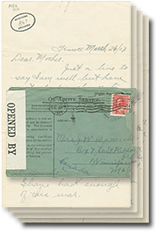
enlarge (6 images)
Archives of Manitoba,
Battershill family fonds,
Letter from George Battershill,
March 26, 1917,
#867-871, P7471/5.
Search Tip: Search the Battershill family fonds in Keystone for more information. All of the George Battershill letters have been digitized and can be read from the database (if you can’t wait for the weekly installments!).
Feedback (0)
E-mail us at [email protected] with a comment about this blog post. Your comments may be included on this page.
15 March 2016
Manitobans at the Battle of Vimy Ridge
The 100th anniversary of the Battle of Vimy Ridge is next month, April 9-12. The Battle of Vimy Ridge represented a major victory for Canada. It was the first time that all four divisions of the Canadian Corps fought together as a unit. Many Manitobans fought in the battle; many died there. Archival records — including letters, diaries, photographs and maps — give us varied, personal accounts of the battle.
We invite you to you learn more about the battle through the words of some Manitobans who were there.
- For the last year, this blog has been featuring letters sent home by Private George Battershill of East Kildonan. George Battershill was injured on the first day of battle at Vimy, and died of his wounds on April 17, 1917. The blog consists of weekly posts featuring the letters he wrote 100 years ago each week. The coming weeks’ blogs will feature his last letters home and then letters written by family members after his death.
- We have other collections of letters written by soldiers. Find more information in our Keystone database. These records can be viewed in our Research Room.
- Charles and Herb Francis are two brothers who served in the First World War. Find their letters in the Sarah Margaret Francis fonds.
- Before he was a weatherman, Ed Russenholt wrote letters home from Vimy. Find these in the Edgar S. Russenholt fonds.
- Stanley Bowen wrote letters home to his fiancé. Find these in the Stanley Bowen fonds.
- We also have diaries and journals from soldiers documenting their Vimy experiences. These records can also be viewed in our Research Room.
- Clarence Boswell served with the Winnipeg Rifles and returned home to be a lawyer in Winnipeg. Find his journal from 1917 in the Clarence Montague Boswell fonds.
- Robert Dennistoun, also a lawyer, was stationed in England during the events at Vimy and his journal documents his observations from there. Find his journal from 1917 in the Robert Maxwell Dennistoun family fonds.
- Rev. George Hambley was a prolific journal writer, filling his notebooks with drawings and ephemera. Find his journal from 1917 in the George Henry Hambley fonds.
The Archives of Manitoba will be featuring these and other records related to Vimy at an event commemorating the 100th Anniversary this April. Watch this blog or our twitter account (@MBGovArchives) for further details!
Search Tip: Search “Vimy” in Keystone to find more information about related records.
Feedback (0)
E-mail us at [email protected] with a comment about this blog post. Your comments may be included on this page.
13 March 2016
One Manitoba Soldier: Opened by censor
This week includes just one letter written by George to his mother. Together with the letter is the envelope it was sent in. Like many, it has a sticker on it indicating that it was opened by the censor.
The green envelopes were given to soldiers and included a declaration that the sender needed to sign indicating “I certify on my honour that the contents of this envelope refer to nothing but private and family matters.” Green envelopes were not subject to the censorship by the soldier’s regiment but could be opened further up the line.
In this letter, George writes to his mother that he continues to stay in the French town where he’s been for a few weeks. He expects that they may be moved out soon. It is quite possible that George is participating in preparations for Vimy Ridge at this time.
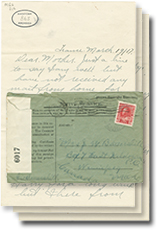
enlarge (5 images)
Archives of Manitoba,
Battershill family fonds,
Letter from George Battershill,
March 19, 1917,
#863-866, P7471/5.
Search Tip: Search the Battershill family fonds in Keystone for more information. All of the George Battershill letters have been digitized and can be read from the database (if you can’t wait for the weekly installments!).
Feedback (0)
E-mail us at [email protected] with a comment about this blog post. Your comments may be included on this page.
6 March 2016
One Manitoba Soldier: George's 20th birthday
This week’s letters from George Battershill, include two written to his mother and two to his father. The last of the four letters was written to George’s mother on March 10th, his 20th birthday.
He writes:
“Just a line to let you know that I did not forget that the 10th is my birthday – and I received your most welcome letter of Feb 15, + the money came in handy. Well Mother this is the first birthday away from home + I hope it is the last. I am fed up with this damn war + everybody in general.”
“I am not writing very much now because it is such a treat to get away from the line for awhile that a fellow nearly goes crazy. … It is nearly a year since I left home, the 27th of this mon., + it seems just like 10 years.”
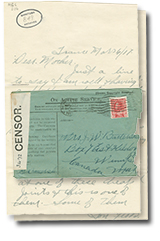
enlarge (4 images)
Archives of Manitoba,
Battershill family fonds,
Letter from George Battershill,
March 6, 1917,
#849-851A, P7471/5.
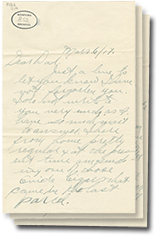
enlarge (3 images)
Archives of Manitoba,
Battershill family fonds,
Letter from George Battershill,
March 6, 1917,
#852-854, P7471/5.
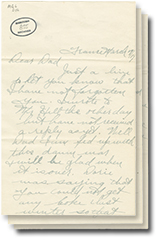
enlarge (3 images)
Archives of Manitoba,
Battershill family fonds,
Letter from George Battershill,
March 7, 1917,
#855-857, P7471/5.

enlarge (6 images)
Archives of Manitoba,
Battershill family fonds,
Letter from George Battershill,
March 10, 1917,
#858-862A, P7471/5.
Search Tip: Search the Battershill family fonds in Keystone for more information. All of the George Battershill letters have been digitized and can be read from the database (if you can’t wait for the weekly installments!).
Feedback (0)
E-mail us at [email protected] with a comment about this blog post. Your comments may be included on this page.



